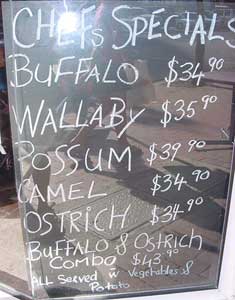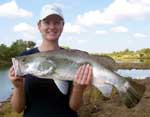 Accommodation | International
Flights | Domestic
Flights | Tours
| Travel
Insurance | Car
Hire | Visas
| Shopping
| Dating
| Humour
Accommodation | International
Flights | Domestic
Flights | Tours
| Travel
Insurance | Car
Hire | Visas
| Shopping
| Dating
| HumourAmazing Australian Foods
The ginormous hamburgers at the Mexican Cafe in Mount Molloy are world famous
For the first approximately 50 000 years that Aboriginal people occupied this country the diet consisted mainly of whatever animals were caught that day or whatever fruit happend to be in season.
Not that Australia had an abundance of tasty tropical fruit though, a lot of seeds need preparation like roasting, mashing and soaking in a creek to rinse out toxins. Also things that do not appeal much to the Europeans like insects and witchetty grubs were eaten.
Witchetty grubs are the larvae of the ghost moth. They are dug out of the trunks and roots of gum trees and traditionally eaten raw, but also cooked on the barbie in more recent times.
When the British settlers arrived they were not at all
interested in this traditional Australian diet and , apart from some animals
they would shoot, fish, or catch, for the first half a century imported
just about all their food from Mother England until they managed to grow
some of the vegetables they were used to back home. The standard weekly
ration in those days was ten pounds of flour, ten pounds of meat, two
pounds of sugar and a quarter pound of tea.
Coffee was not drunk in those days, it took till 1955, 177 years after
the arrival of the First Fleet for espresso machines to arrive and finally
Aussies could have a decent cup of coffee. If you travel through remote
areas you may still find there can be as much as a 1000 km. between stops
where they have decent coffee, outback roadhouses are not known for their
high cuisine.
The gold rush in the late 1800s revolutionized the dining
scene as many Chinese came to look for gold and those that could not find
any gold opened up Chinese eateries.
The big migration wave in the 1950s that included a lot of Italians and
Greeks revolutionized the Aussie diet, that was still mainly steak, frozen
peas and potatoes, again when spaghetti and pizza were introduced.
Although the Italians, then often referred to as 'wogs', were at first
not very popular with the white Australians it is lucky they arrived as
life without pizza would be unimaginable for many Aussies now. Also spaghetti
bolognaise, in Aussie slang known as Spag Bol, is now the most commonly
cooked dish at home in Australia, according to research by Dr Adele Wessell,
a historian at Southern Cross University.
The 1960s and 70s saw, with economy going well and people having money
to spend, another boom in restaurants from many nationalities opening
up.
In the 1980s, with more Asian immigration happening, the country saw a
boom in the popularity of Thai resaurants.
During the 1990s with increasing tourism Australia's native animals started
filling the restaurant menus, many people like to try a bit of kangaroo,
emu or a croc burger during their holiday in Australia.
Now in the 21st century 'fusion cooking' seems to be the way
to go, mixing all the different cuisines of the world, as demonstrated
by countless 'this is how you do it' TV chefs in cooking shows. Aussies are eating out more and more, seven times a month on average. Chinese was the number one choice, followed by modern Aussie, Italian, Thai, Indian, Japanese, Mexican, Vietnamese, Greek and French. Two-thirds of diners went to fast-food chains, 59% to restaurants and 50% to cafes, and they spend an average of $79 at restaurants and $57 a month on takeaway each month. |
|
Amazing Australian food experiences
Don't eat in just any restaurant, check out the options below for some very memorable ding experiences!
Anzac Biscuits

Anzac biscuit
During World War 1, the wives, mothers and girlfriends of the Australian soldiers were concerned for the nutritional value of the food being supplied to their men. Here was a problem. Any food they sent to the fighting men had to be carried in the ships of the Merchant Navy. Most of these were lucky to maintain a speed of ten knots (18.5 kilometers per hour). Most had no refrigerated facilities, so any food sent had to be able to remain edible after periods in excess of two months. A body of women came up with the answer - a biscuit with all the nutritional value possible. The basis was a Scottish recipe using rolled oats. These oats were used extensively in Scotland, especially for a heavy porridge that helped counteract the extremely cold climate.
The ingredients they used were: rolled oats, sugar, plain flour, coconut, butter, golden syrup or treacle, bi-carbonate of soda and boiling water. All these items did not readily spoil. At first the biscuits were called Soldiers’ Biscuits, but after the landing on Gallipoli, they were renamed ANZAC Biscuits.
A point of interest is the lack of eggs to bind the ANZAC biscuit mixture together. Because of the war, many of the poultry farmers had joined the services, thus, eggs were scarce. The binding agent for the biscuits was golden syrup or treacle. Eggs that were sent long distances were coated with a product called ke peg (like Vaseline) then packed in air tight containers filled with sand to cushion the eggs and keep out the air.
As the war drew on, many groups like the CWA (Country Women’s Association), church groups, schools and other women’s organisations devoted a great deal of time to the making of ANZAC biscuits. To ensure that the biscuits remained crisp, they were packed in used tins, such as Billy Tea tins. You can see some of these tins appearing in your supermarket as exact replicas of the ones of earlier years. Look around. The tins were airtight, thus no moisture in the air was able to soak into the biscuits and make them soft. Most people would agree there is nothing worse than a soft biscuit.
During World War 2, with refrigeration in so many Merchant Navy Ships, the biscuits were not made to any great extent. It was now possible to send a greater variety of food, like fruit cake.
ANZAC biscuits are still made today. They can also be purchased from supermarkets and specialty biscuit shops. Around ANZAC Day, these biscuits are also often used by veterans’ organisations to raise funds for the care and welfare of aged war veterans.
This information on Anzac biscuits courtesy of Anzacday.org.au
Aussie recipes
Do some Aussie cooking! Cook up the recipe below or hit
the refresh button to reload this page and a new Aussie recipe will pop
up!
Try a Pikelet
recipe, better known as Australian pancakes. The Pikelet may not be as
adventurous as a scallion
pancake recipe, but it's perfect for breakfast or tea time.
Barbeque
A very important ritual to many Aussies. If you are staying with the locals there will no doubt be at least one "barbie" during your stay. Australia is modernizing but traditionally a barbie used to be men around the barbie plate dressed in blue singlet, stubbies and thongs, holding a beer in one hand, in the other hand some implement to roll around the snags (sausages) and steaks until burned crunchy black while talking football and cars, meanwhile women congregated at the other end of the yard to discuss household and babies, seated on folding chairs and eskys.
Barramundi
Very popular fish with both fishermen and restaurant diners,
many people are not satisfied with their holiday until they have caught
or eaten at least one of them.
Barramundi live in the rivers of Far North Australia, and are part of
a large fishing industry in Australia. Barramundi are able to live in
salt water, and head to the sea to spawn. When the fingerlings are born
they are male, although after about 4 years they turn into females.
Burgers
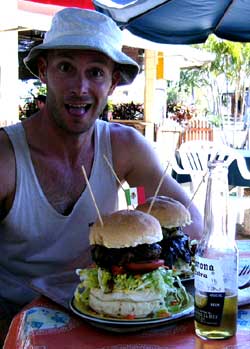
The hamburgers in Mount Molloy are ginormous
Australians like their hamburgers. Hamburgers, steak burgers,
roo burgers, chicken burgers, fish burgers, you name it, every roadhouse
has got them.
But the burgers in Mount Molloy have been voted best hamburgers for many
years and have featured in many magazines, and above you can see why.
You will find Mount Molloy in north Queensland, on the inland road from
Cairns to Cooktown. The Lobo Loco cafe that cooks them is two doors down
from the local pub.
Bush tucker
If you recall the TV series 'Bushtucker Man' from a few years ago (where Les Hiddins would dig up food left right and centre that usually tasted a little bit like chicken) you will know there are a lot of things in the Australian landscape that are edible, though they often need to be prepared in certain ways. The Australian Aborigines have perfected the art of bush tucker for 40 000 years and can find an amazing array of foods in the bush and they can survive anywhere.
Witchetty grubs - they are the larvae of the ghost moth. They are dug out of the trunks and roots of gum trees and traditionally eaten raw, but also cooked on the barbie in more recent times.
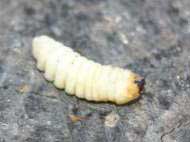
Witchetty grub
We have heard reports that you can even buy witchetty soup in Aussie supermarkets nowadays, if your local Wooly's doesn't have it cook it yourself at home; chuck a dozen fresh witchetty grubs in some oil and saute for a while, then add a litre of stock, some crumbled chicken cubes, some dried onions, native peppercorns, and a bit of salt. Let all this cook for half an hour or so and then add some thickened milk. Finish off with a flour paste to thicken and sit down and bon appetit!
In March 2005 Prince Charles toured the Alice Springs Desert Park and Arrernte women had dug up some witchetty grubs for him and collected sweet honey ants but palace staff told them not to give Charles any bush tucker to sample unless he asked for it.( Only 28 of the town's 30000 residents had come out to see him, the other 29972 Alice Springers had something more important to do that day.)

Green ants - while it may take a while to fill your stomach you should try at least a couple, you will be surprised at the refreshing, tangy lime flavour. Try tossing a whole nest of them into some boiling water to improvise lemon tea.
For some more refined bushtucker visit the website bushtuckershop.com where you will find scrumptious native fruit jams, wicked marmalades, rare native spices and seasonings, gourmet sauces & spicey chutneys, wild hibiscus flowers in syrup, tasty macadamia nut creations, pungent mustards, native herbal teas and native essential oil cosmetics.
Cheese
Australians produce a big variety of cheeses but many are imitations of European brands bearing the original names like Gouda, Edam etc. While some years ago an advertising campaign on TV had an Aussie praising the local varieties and claiming that " because it's made from Australian milk I reckon it is even better", I can assure you that , being born and raised in Gouda myself, the Aussie variety is NOT the real thing.
Crocodile
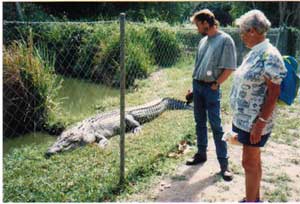
Tastes a bit like chicken, although crocodiles are protected the meat is available from crocodile farms, many tourist places around Australia have it on the menu, either as steak or croc-burger.
Damper
A mix of flour and water cooked in a pot or in aluminium foil on the campfire to form hot freshly baked bread even when you're miles away from town or bakery. Traditionally flour and water but improvements can be made by adding more ingredients;
Get one big tin of either peaches or apricots, and mix this
with one kilo of wholemeal self raising flour.
The liquid in the tin is exactly the right amount to get the right mix
and no other water should be needed.
Also mix in some cinnamon, then wrap the big lump in aluminium foil or
place in camp oven and place in or on fire for half hour or so, depending
on heat.
Emu

Though tasty, the meat is a little tough and best eaten thinly sliced. Emus are farmed nowadays for their meat, feathers and oil.
Feral cat cooked to purrfection
Kaye Kessing from Alice Springs says she will never boil
a cat.
Because they are much better roasted or sauteed!
In the 2007 Wildfoods Recipe Challenge of the Alice Desert
Festival she delighted the judges with her dish of feral cat cooked to
purrfection with quandong, native lemongrass and some Murray River salt,
first thrown in a frypan and then simmered in a crockpot..
She said this one is even better than her other favorite dish, the catterole.
It is essential that the cat is cooked well done to kill any bacteria,
and the taste is described as white meat but not as gamey as rabbit.
Kaye said she has been eating feral cats for 15 years now and that it
is a common thing for local Aborigines to eat. She has published a wildfood
cookbook that also includes feral pigeons and camels, and says that by
eating feral animals you are doing a good thing for the environment.

Feral cats should NOT be eaten raw
but well cooked
Floater
This traditional Aussie dish originates from Adelaide. It is a meat pie floating in a bowl of pea soup.
Galah
One time I arrived at a remote roadhouse with three dead
galahs on the bumperbar of my bus. I offered them to the chef at the roadhouse
and said I had only just hit them and the were nice and fresh.
His reaction;
GALAHS? Mate, there's only one way to cook those bastards; stick'em in
a camp oven (heavy cast iron pot) together with a rock, cook them till
you can stick a fork in the rock, and then you throw away the galah and
eat the rock!
In other words; they're pretty tough.
Kangaroo
While nowadays you can get a roo burger in many tourist
places the consumption of kangaroo meat was banned for most of the 20th
century. It certainly would have been much better for the Australian environment
had people always eaten kangaroos rather than beef as the altering of
the landscape by grazing cows has done some serious environmental damage.
Kangaroo meat comes in a wide range of cuts and is widely available from
supermarkets throughout Australia.
Some of the advantages of kangaroo meat over others like
beef;
- It has almost no fat
- No hormones, steroids, anti-biotics, and what ever else that can get
pumped in to commercially farmed meat.
- No transport and slaughter house stress on the animal, they stand around
in the bush, get hypnotized by a bright spotlight and bang, a quick end.
- No forest needs to be cleared for farming areas like cattle stations,
they hop around in a undisturbed natural environment.
It is very high in protein and iron but low in fat, usually less than 2% which is less than most other red meats so it should be cooked carefully to avoid drying out during cooking so it is important to follow a few simple steps to retain the moisture in the meat;
- Soak meat in oil for at least 15 min prior to cooking,
then place in a very hot pan and quickly turn over to ensure all sides
are 'seared', (browned). This will seal the moisture inside the meat.
- When pan frying the temperature can then be turned down a bit and the
meat cooked to medium rare. If roasting it can be transferred to the oven,
but do not cook further than medium rare.
Guide to cooking times
Stir Fry: (5mm thick) 1 minute maximum
Kebabs: (1.5cm cubes) 2 minute per side (leave space between cubes)
Medallions: Steaks (2.5cm thick) 2-3 minutes per side.
Roasts: Brown in pan then cook in pre-heated oven for 8-12 minutes per
500gms at 220 degrees Celsius or 15-20 minutes at 200 degrees Celsius
(thick roasts may take longer than thin regardless of weight).
Kangaroo mince can be cooked exactly as other minces.
The kangaroo meat industry suffered a blow when Russia banned it, being concerned about hygiene in the bush, and now animal activists in Europe are trying to ban it for moral reasons, they are not happy with the fact that after pregnant females are shot the joeys are also killed with a quick blow to the head.
Lamingtons
Small squares of plain cake, dipped in melted chocolate and sugar and coated in desiccated coconut, named after Baron Lamington who was the governor of Queensland from 1896 to 1901.
Meatpie

The famous Aussie meat pie
The Aussies love their meatpies, although it remains a question
how much meat is actually in some of them, to qualify as a "meat
pie", a pie has to contain 25 per cent meat flesh as defined by the
Food Standards code.
Another important part of the meatpie eating experience is tomato sauce
which is generously dumped on the pie. A couple of years back a Brisbane
meatpie manufacturer announced the invention of the pie with in-built
sauce, althought the first reactions were ecstatic it does not appear
to have taken off much after that.
January 2004 saw another revolution; the new lite pie was launched by
Four'n Twenty and is designed to appeal to health conscious pie-lovers.
It even has been approved by the National Heart Foundation as it has about
half the fat, reduced saturated fat and sodium content of a traditional
meat pie.
Statistics show men eat twice as many pies as women, Queenslanders eat
more pies per head than any other state, and all Aussies together they
eat 260 million of them every year with August being the peak consumption.
August is also the dying peak season for for the 124 000 Aussies that
die every year, this may be coincidence.
The meatpie is also a vital ingredient in 'The Floater'; a traditional
Aussie dish originating from Adelaide. A floater is a meat pie floating
in a bowl of pea soup.
The pie has been around for around 150 years and it is not clear who actually
invented this Australian icon.
Indian billionaire Pankaj Oswal and his wife Radhika decided to get a $70 million mansion built in the exclusive suburb of Peppermint Grove in Perth. They told all the numerous builders on the site that eating meat creates bad karma and banned it from the building site! Can you imagine the horror of the builders and the Western Australian Construction Union, NO MEAT PIES FOR SMOKO !!!
Choice Magazine put the Aussie pie put to the test in 2010
with a survey in which they examined the 20 most popular supermarket pies
on taste, meatiness, nutrition and value for money.
The first prize went to Aldi's Elmsbury Bakehouse Premium Grain Fed Beef
Pie, the meatiest pie prize went to Herbert Adams King Island Gourmet
Premium Beef Pie with a 38.5 per cent meat content, the tastiest pie went
to Four'n'Twenty, followed by Black & Gold. Coles' pies failed to
really impress the judges.
Pavlova
In 1935 the great Russian ballerina Anna Pavlova visited Australia and Herbert Sachse, the chef of the Hotel Esplanade in Perth, created the pavlova. Others reckon this dessert was invented in New Zealand, but it has become recognized as a popular Australian dish.
Spag bol
Dr Adele Wessell, a historian at Southern Cross University has done research on what Aussies most often cook at home and has found that spaghetti bolognaise, called spag bol by Aussies that like to abbreviate everything in life, is Australia's national dish! She will present her findings to the British World Conference in Melbourne from July 2 to 4, entitled 'There's no taste like home: the food of the empire'.
Tim Tams

Image from Arnotts.com
Tim Tams are more than a biscuit, they're a part of Australian
culture since 1963. Many Aussies are self confessed Timtamoholics. Tim
Tams are Australia’s favourite chocolate biscuit. Around 30 million
packs are sold each year - that’s nearly 300 million biscuits, or
two packs for every Australian. There are eight delicious varieties of
Tim Tams: Original, Chewy Caramel, Mocha, Double Coat and Classic Dark
Chocolate, Special Edition Tim Tam Hazelnut, Limited Edition White Chocolate
and new Special Edition Chewy Choc Fudge. Early 2004 they also introduced
new flavors like Tia Maria which drew criticism from the politically correct
crowd claiming they were trying to turn their kids into alcoholics but
fortunately this storm died down again. They also produce a kosher version
for the Jewish market. Some years ago a local radio station had a competition
for their listeners to ring in and tell everyone your favorite way to
eat Tim Tams, as Aussies have invented endless ways besides the normal
put it in your mouth and chew.
One technique was the Tim Tam slammer;
bite both ends off the biscuit, then use it to suck coffee out of your
cappucino or latté. Make sure you have a spoon handy, because the
biscuit is liable to quickly break up. Suck as much coffee through it
as you can and, when you feel it breaking up, quickly ram the melting
biscuit into your mouth with the spoon. You can also suck your favorite
liquer through it this way. Some other suggestions from callers were too
rude or gross to list here.
You can buy your Tim Tams online at Arnotts.com
.
69% of Aussies like sharing Tim Tams with friends
40% of Aussies hide Tim Tams from friends and family
66% of Aussies like to eat Tim Tams when watching TV
3% of Aussies eat Tim Tams in the bath
Cairns is the Tim Tam sales
capital of Australia with Japanese and Korean tourists buying up to four
cartons (eighty packets) each to take home, the Abbott St. Woolworths
sells 4500 packets a week!
Toasted Marshmallows
If you end up in a situation sitting around the campfire with your Aussie hosts you are bound to come across this phenomena; put a marshmallow on a stick, hold in near or in the flames till it has melted or half cremated and then eat it.
Vegemite

Invented by Fred Walker in 1923, this is a dark yeast extract made from the leftovers of beer brewing, similar to Promite and Marmite, which Aussies spread on sandwiches. It is that important to them that Australian embassies around the world frequently get calls from desperate Aussies asking where they can find the Vegemite importer in that country. Newcomers to Australia are unlikely to enjoy this powerful tasting stuff and usually have only one try, pull some funny faces and then never touch it again, it tastes very salty, even though the salt content has been reduced from 10 to 8 percent. In 1935 U.S. based Kraft Cheese bought Vegemite so this Australian icon is not even Australian owned anymore. You can even cook with it to produce some real Aussie tucker.
July 2004: Jewish Aussies were in shock when Kraft Foods
Australia announced it will cease production of kosher Vegemite after
20 years. Panic buying ensued with some stressed out Jewish shoppers buying
as many as 35 jars as they can not imagine llife without Vegemite.
In 2009 Kraft came up with the idea to start producing a blend of Vegemite
and Kraft cheese, supposedly easier to spread and milder in taste than
the original. A competition was held for the public to come up with a
name for the new stuff which was won by 27 year old West Australian web
designer Dean Robbins who came up with the name iSnack 2.0 , Dean was
beside himself with pride and thought he'd go down in Australian history
as the one who named the new icon, but only four days later, long before
statues of Dean could be built or his face placed on stamps and coins,
Kraft announced that nobody liked the name and they're going to choose
a new one. Once again the help of the public is requested, this time to
choose a name from a shortlist of six; Cheesybite, Creamymate, Smooth,
Snackmate, Vegemate and Vegemild.
Latest news flash 07/10/2009; the new name is Cheesybite!
HOME PAGE
Tourist Information
General Information
And Entertainment
ACCOMMODATION IN AUSTRALIA
Bed
& Breakfast
Budget
Accommodation
Backpackers Hostels
Hotels
in Australia
CAR HIRE IN AUSTRALIA
Australia Rental Cars
And
Campervans

TOURS
IN AUSTRALIA
What To Do In Australia
On-line
Shopping
On-line
Dating
![]()
About
Australia
Visas For Australia
How
To Get To Australia
How To Get Around
Travel Insurance
Travel Guides
Working
In Australia
Australian
Posters
Survival
Tips
Weather,
When To Go

Use of
this website constitutes acceptance of the User Agreement for this website
Contact us |
Advertise on this site
| Link to this site |Add
your photos or stories to this site |
Webmasters | Affiliates
